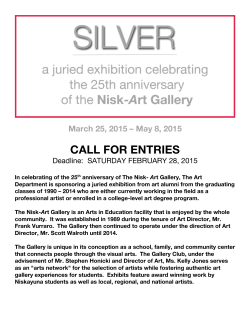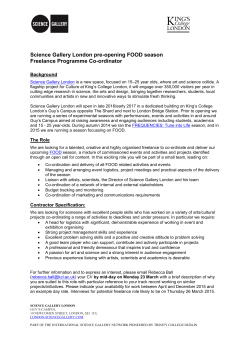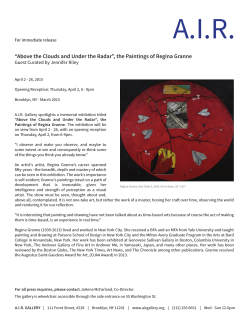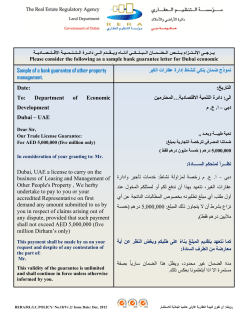
Gil Heitor Cortesao, Hazem Mahdy, Sara Rahbar
19 MARCH 2015 I ISSUE 3 I ART DUBAI EDITION
Review of the
Sikka Art Fair
in the Al-Fahidi
Historical
Neighbourhood.
Kaveh Golestan's
solo presentation at
Art Dubai's Modern
section, curated by
Vali Mahlouji
Canvas Daily
suggests you don't
miss these gallery
shows while you
are in the UAE.
PAGE 04
PAGE 10
PAGE 12
ARTISTS ON SITE
The fourth Artist in Residence programme run by the Dubai Culture and
!"#$%!&#'(")#*+%,-$'.//0+%1/023-%4(&35-#)(3%-35%!"#%1&6-)7
CURATED BY LARA Khaldi, six artists over three months develop projects: Mohammed Ahmed Ibrahim, Hind
Mezaina, Sharmeen Syed, Jessica Mein, Mehraneh Atashi and Rheim Alkadhi took part in studios, outreach
programmes, talks, readings, screenings, publications… the complete immersive creative experience. It gives artists
the chance to pursue their fascinations, providing both the platform and the support to realise their artistic goals.
MOHAMMED AHMED IBRAHIM (UAE) has exhibited extensively throughout local and international
Land Shift And Fresh And Salt,
2015. Land art intervention and
sculpture. Variable dimensions.
biennials. Ibrahim’s AiR work is consistent with his practice of using organic found materials manipulated into gentle
ambiguity. However, the wire-bundled stone sculpture maintains its integrity, offering a glimpse into the importance
of stones and their “primordial role in different cultures, especially Arab culture” and the naturally occurring
environment that create Ibrahim’s physical and artistic environment.
CONTINUED ON PAGE 12
Marwan Kassab Bachi. Untitled. 1977. Image courtesy Barjeel Art
Foundation, Sharjah.
Day two sales: slow but sure?
VIRTUAL EXHIBITION
8#9$%-%:);/5%<)=#&"/>%$(:/%-"/%'-<<)/"%#'-3%(#'/"$7
SALES PROVED ELUSIVE for some galleries
on day two, with comment around the
stands on how greater footfall might
help ease an otherwise cautious mood.
One European gallerist was prompted
to muse, “I thought this year would be
busier compared to last, because of the
Sharjah Biennial, but it seems people
went to The Armory Show and to Art
Basel Hong Kong and then home.”
Even so, whilst some galleries were
still struggling to make their first
sales, others were pulling off sales
to institutions. Beirut’s Agial Gallery
Kamrooz Aram. Untitled (Palimpsest #35). 2015.
Oil and oil crayon on canvas. 213 x 183 cm. Image
courtesy the artist and Green Art Gallery, Dubai.
SHARJAH – The Barjeel Art Foundation, in collaboration
with the Google Cultural Institute, presents Art Project And
Archive, an exhibition featuring over 430 works from the
collection by artists such as Marwan Kassab-Bachi, Dia AlAzzawi and Yto Barrada, among others. Visit www.google.
com/culturalinstitute
CONTINUED ON PAGE 8 >
CONTINUED ON PAGE 3
19 MARCH 2015 I CANVAS DAILY I ISSUE 3 I ART DUBAI EDITION
1
Day two sales: slow but sure?
CONTINUED FROM PAGE 1
(M10) sold a Shafic Abboud work to Mashreq
Private Bank for between $70,000–90,000,
while Latitude 28 (J19) sold two pieces by Dilip
Chobisa, one to an institution in North America
and the other to a Riyadh-based collector.
Meanwhile, Carbon 12 (A23) sold a Sara
Rahbar work, Holding Onto Nothing But You,
to the Davis Museum in the USA for between
$20,000–50,000, and Gallery Isabelle van den
Eynde (J18) sold Keys (1995) by Mohammed
Kazem for $10,000 to an institution in the UAE.
Elsewhere, a regional collector relieved Pi
Artworks (A43) of a large Gulay Semercioglu
work for between $50,000–60,000. Green Art
Gallery (A26) sold a Kamrooz Aram work for
$40,000, and Rodolphe Janssen (A20) had two
notable sales: a Walead Beshty transparency for
$25,000–30,000 and an untitled Gert & Ume
Tobias work for $32,000–37,000.
Pechersky Gallery (A10) were delighted to
sell an untitled work by Rachel Lee Hovnanian
to a member of the UAE royal family for
$35,000, while Kashya Hildebrand (A32) built
on its opening day success with the sale of The
Funeral by Marwan Sahmarani for $28,000 to
a local collector new to the gallery. Albareh Art
Gallery (J26) sold a piece by Zuhair Al-Saeed
to a regional collector for $15,000, while Leila
Heller Gallery (J23) sold a Noor Ali Chagani
work for $10,000 to a British collector, with
MA2 Gallery (A7) selling Ken Matsubara’s The
Sleeping Water Storm In A Glass for $10,900.
Galleria Franco Noero (A12) reported holding
two works on reserve.
Selma Feriani (A18) had several sales,
including three Pascal Hachem works for
$4500–7000 and Yazid Oulab’s Clou for
$15,000. Canvas Gallery (J9) sold Ayaz Jokhi’s
Marilyn Monroe for $8500, while Nathalie
Obadia (J21) sold a work by Ricardo Brey to a
Dubai-based collector for $6500. Grosvenor
Gallery (A27) sold a work by Faiza Butt for
$6000, with Agial Gallery (A42) selling several
drawings by Heba Kalache for $3000 each
to Lebanese, Egyptian and Emirati collectors.
Victoria Miro (A33) sold three works by Idris
Khan for undisclosed prices. Among the
Moderns, Lisbon’s Perve Galeria (M4) sold
several works in the $8000–10,000 range,
including by Ernesto Shikhani and Manuel
Figueira, with Loft Art Gallery (M15) selling
three Mohammed Melehi pieces.
Shafic Abboud. Composition. 1958. Oil on panel. 92 x 64
cm. Image courtesy Agial Gallery, Beirut.
ERRATUM
In Issue 1, Canvas Daily mistakenly
reported that Gallery Isabelle van
den Eynde (J18) sold a work by Rokni
Haerizadeh for $130,000. The work is
a collaboration between Rokni, Ramin
Haerizadeh and Hesam Rahmanian.
Also, in One On One with Abdelmonem
Alserkal on page 8, the date of Ayyam's
opening in Alserkal Avenue is 2008.
THE ROAR/MEOW PARADOX
Sara Rahbar. Holding On To Nothing But You. 2014. Bronze with black wax. 140 x 15 x 13 cm. Image courtesy Carbon 12, Dubai.
?'-&3-%@)='-"5$(3A$%B="(='/#5/":*A%)$%-#%1/$)C3%1-*$%1&6-)7%
She is the small woman hovering near the life-sized
taxidermy lion perching on a plinth. Its energy implies
ferocity with realistic bared teeth, but on closer
inspection, it becomes apparent that this lion is a knit
skin-sack made of mohair. No cuddly toy – Shauna
Richardson intentionally avoids twee characteristics
in what intrinsically should be so by avoiding pattern,
focusing on linear patterning and attempting realism
as far as her crochet-needle and wire frame work
will take her. Popular in its unorthodoxy, Richardson
explains that one work takes several months as she
produces it by hand, usually for commission. The
individuality of her work is mirrored by the collectors;
she has never had to create the same animal twice.
Shauna Richardson. Crochetdermy
Lionness. 2009. Mohair wool and black
walnut plinth. 102 cm. Image courtesy
the artist and Design Days Dubai.
While a shocking discovery in Design Days Dubai,
a space filled with all that glitters (but not necessarily
gold), Richardson’s design at the Crafts Council
booth is a palette cleanser: kitsch but realistic and
unapologetically out of place. “When you look
at accessible things like animals, it makes people
uncomfortable to accept it as contemporary, but
that is why I use subjects like that, to be accessible,”
she says. However, a work that is willing to embrace
itself on the merits of its own values? About as
contemporary as it gets. But unlike the unfathomable
non-boundaries of contemporary creations,
Richardson’s ‘crochetdermy’ has limits – “I’ve said no
to a hare with a veil on it.”
MARCH/APRIL 2015
VOLUME 11 ISSUE
2
We Live In The Exoskeleton Of The Internet
By James Bridle and Omar Kholeif
16:15–16:45
BOOK LAUNCH: Shafic Abboud by Pascale Le Thorel
Agial Gallery (M10), Art Dubai Modern, Mina A’Salam
16:00
Media Free Zone Authority.
and Hessam Rahmanian
Gallery Isabelle van den Eynde (J18), Gallery Hall 2,
Madinat Jumeirah
17:00
Dubai Technology and
Published out of the
Beatrice Bulgari’s The Lack
A4 Art Spaces, Alserkal Avenue
18:30
| €16
Zone Authority.
and Media Free
the Dubai Technology
Published out of
| £15.00 | €16
| LBP 32,000 | US$25
| BD/OR 7 | SR 90
SUE 2
Etel Adnan
Lebanese artist,
writer and poet
,
over our region
it is shining
ng – indeed,
are also
Light is shini
darkness, there
e there is most
, since it bebecause wher
is one of them
(1%
spots. Canvas
0-%",
test
brigh
%(-,'/
the
"()'*%'+%&)+$
',%(-$%"+.,#
ir and we are
!"#$%"%&'!"()'*%+
ance to despa
ng in the resist
, every
Light is shini
with every poem
going further:
ing in
resisting. We’re
tion, every build
technical inven
concert, every
on, with every
Leban
t
tree on Moun
d with love,
the Gulf, every
cooke
meal
with every
and shall
look at the sky,
se we are here
further. Becau
whoever
we’re going
disappearance,
ver wished our
it’s too
be. And whoe
ver thinks that
doomed, whoe
in
thought we were
ment. We’re
great disappoint
a
to
up
is
morning; it
late for us,
is rising every
But the sun
yes!
oh
le,
still do it, we
troub
time and will
us for a long
for
it
done
.
has
very happy
somehow we’re
Etel Adnan
know it. And
poet
, writer and
Lebanese artist
AED 45 | QR 65
1
BOOK LAUNCH: Ramin Haerizadeh, Rokni Haerizadeh
FILM SCREENING
7 | SR 90 | LBP 32,000
| US$25 | £15.00
AED 45 | QR 65 | BD/OR
ER PRINTING_2.indd
GLOBAL ART FORUM 9:
DOWNLOAD UPDATE?
GLOBAL ART FORUM 9:
DOWNLOAD UPDATE?
Lebanese artist, poet and writer Etel Adnan’s witty text about light and enlightenment
graces the cover of Canvas’s March/April issue
– indeed, it is shinin
g over our region
because where
,
there is most darkn
ess, there are also
the brightest spots.
Canvas is one of
them, since it be!"#$%"%&'!"()'*%+',%
(-$%"+.,#"()'*%'+%&)+
$%(-,'/0-%",(1%
Light is shining
in the resistance
to despair and we
resisting. We’re
are
going further: with
every poem, every
concert, every
technical invent
ion, every buildin
the Gulf, every
g in
tree on Mount Leban
on, with every
look at the sky,
with every meal
cooked with love,
we’re going furthe
r. Because we are
here and shall
be. And whoever
wished our disapp
ppearanc
ance,
e, whoever
thought we were
doomed, whoev
er thinks
ks that
hat it’s
late for us, is up
itt’ss too
to
to
o a great
great disapp
disap
pp
pointme
oint
ntmen
ntt. We’re
nt.
We’re
We
trouble, oh
re in
h yes!
ye
es! But
Butt the
th sun
s n is rising
su
r ng every morni
risi
has done
ng; it
e itt for
fo
orr us for a long
time and will still
do it, we
know it. And
An
nd someh
nd
so
ow we’re very happy.
Today's Schedule
Values, Virtues And The Virtual
By Georgina Adams, Sebastian Cwilich, Thomas Galbraith and
Anders Petterson
15:15–16:15
IN THE CANVAS MARCH/APRIL ISSUE
Light is shining
Gulay Semercioglu. Untitled. 2014. Wire, screw and wood.
210 x 215 cm. Image courtesy Pi Artworks, London/Istanbul.
PM
2/24/15 2:52
TOUR
Modern*
18:30–19:00
Mehmet Ali Uysal
Uysal breaks away from the
confines of the four walls of
the gallery to comment on the
process of Contemporary art.
Abbas Akhavan
The Iranian artist explores
narratives of domestic space
to comment on notions of
hospitality and hostility.
Common Ground
Artists reflect on narratives
pertaining to violence, gender,
transport and consumerism to
create works using cars.
TOUR
Marker*
19:00–19:30
Book a place on the tour at any of the information desks. All
Global Art Forum 9 session are held in Mina A’Salam, next to
Art Dubai Modern.
For more information, visit www.artdubai.ae
19 MARCH 2015 I CANVAS DAILY I ISSUE 3 I ART DUBAI EDITION
3
CHRISTIE'S
DUBAI AUCTION
The top four lots from the Christie's
Modern and Contemporary Arab,
Iranian and Turkish Art, which was
'/05%0-$#%3)C'#7
SIKKA at 5
SIKKA 2015 marks the fifth edition
of the artist-led satellite fair for
emerging UAE-born or based
talent, occurring in tandem with
1&6-)%!"#%E//.7
GLOBAL ART
FORUM 9
18 MARCH
Hazem Mahdy. Hic. 2015. Plastic 3D print. Variable dimension.
Shumon Basar opened the first day of the Global Art Forum:
Download Update? at Art Dubai with, “We are promiscuous in our
1
interests. Art, either contemporary or otherwise, is not given VIP
treatment in the Global Art Forum. Curiosity, unlike fossil fuels or
Bestselling lot on the night was Tahia Halim Farhat Al-Nuba (The
polar bears, is, we believe inexhaustible.”
Happiness of Nubia), which went under the hammer for $749,000
against its high estimate of $180,000, representing a new world record
for the artist at auction.
2
Sawsan and Bahar Al-Bahar. LUZ. 2015. Light installation. Variable dimension.
Images courtesy Sikka.
Strangers, Welcome: New Invisible Publics saw Gala Berger, Gabriel PerezBarriero and Jack Persekian discuss the presence and importance of the
Internet in their respective institutions. “In this era, everyone is trying to
digitise whatever they have for fear that these things might get lost. In
Ayman Baalbaki's Babel also sold for a world record price for the artist
the context of Palestine, maybe destroyed. A lot of these institutions are
at auction, going for $485,000 against its high estimate of $200,000.
doing that, or trying to, or looking for solutions. What is so ridiculous is
that each and every one is trying to do it on their own, an island on their
own. Trying to create the wheel,” said Persekian.
3
Third highest selling lot was Abdulnasser Gharem's Hemisphere, which
also sold well above its high estimate, at $400,000 against $180,000.
Monir Shahroudy Farmanfarmaian's
Zahra's Image achieved a hammer
price of $395,000 against its low
estimate of $350,000. New York's
Guggenheim opened a show for
the celebrated Iranian artist on
13 March, curated by Suzanne
Cotter, who presented a show for
Farmanfarmaian at the Serralves
4
Museum in Porto last October.
1. Farhat Al-Nuba (The Happiness Of Nubia). 1965. Oil and gold leaf on paper laid
down on canvas. 130 x 251.5 cm. 2. Babel. 2005. Acrylic on canvas. 260 x 200 cm.
3. Hemisphere. Digital print and industrial lacquer paint on rubber stamps on
aluminium in three parts. 240 x 360 cm each. 4. Zahra's Image. 2009. Mirror mosaic,
reverse-glass painting and plaster on wood in aluminium. 185 x 135 x 19 cm.
All images courtesy Christie's.
4
19 MARCH 2015 I CANVAS DAILY I ISSUE 3 I ART DUBAI EDITION
In the Al-Fahidi historical neighbourhood of Dubai, mixed media
artist Jalal Luqman curates, with the support of the Dubai Culture
and Arts Authority, a platform of commissioned works from 48
artists with multidisciplinary approaches.
One artist, Hazem Mahdy, has taken the opportunity
of the environment SIKKA provides to expand upon his
usually photographic practice, saying, “My piece is called
Hic, a Turkish word for void or nothingness. It is a plastic
3D print of interconnected arms in an upwards spiralling
motion in a room covered in black trash bags to absorb
the light so the piece fills the space with its shadows. It
invites the viewer to become part of this mystical experience
of whirling in nothingness as the Sufis of Turkey do.”
SIKKA is an environment that pushes artistic and curatorial
independence and some experimentation. For example, Wael
Hattar presents A Heaven For Sale, a black-walled enclosure
with peep-holes and ‘for sale’ signs both at the location and
online. “It’s a tongue-in-cheek look at making the public
private,” says Hattar, of the work that indicates that the
repercussions of presentation can turn the for-granted into
the conceptual. Further indicative of the SIKKA expansion,
Mobius Design Studio overtakes and commissions a work for
dedicated space – this year’s thematic being ‘Re-ornament’
and interpreted by Sawsan and Bahar Al-Bahar’s LUZ light
sculpture in spatial deconstruction of muqarnas geometry.
Other works include Michael Conduit’s drawings which
he, as a teaser, describes as, “de-orientalising ‘the other’”;
architect Noor Jarrah’s collaborative work with graphic
designer Sara Al-Aqroobi, Ayn, a hallway installation that
deals with jealousy and protection from it via manipulated
planes of view; and Sumaya Al-Rais’s still-life watercolour.
Architecture Effects: Moving On After Progress saw Troy Conrad musing
on new frontiers, the digital age and pop culture, lamenting before his
talk was cut short due to time constraints, how “Off the record, it may
be a Greenberg-ian view, but art should be experienced.”
Too Long, Didn't Read involved Christopher Bevans in conversation
with Turi Munthe D who, following the fashion-based discussion,
noted, “You just re-spelled ‘textiles’ as tech-styles!”
All images courtesy Art Dubai.
HOW SUSTAINABLE
IS THE MARKET FOR
MODERN REGIONAL
WORKS?
VALERIE HESS,
CLIENT LIAISON AND
SALE MANAGER,
CHRISTIE’S
Ziad Antar. Intensive Beirut (XVI). 2014. C-print. 120 x 180 cm.
Edition of four. Image courtesy Selma Feriani Gallery,
London/Tunis.
Safwan Dahoul. Dream 93. 2015. Acrylic on canvas. 180 x
200cm. Image courtesy Ayyam Gallery.
The Syrian-born artist explores the corporeal and psychological
effects of solitude and longing, a notion continued in his Dream
series. This painting (price undisclosed) incorporates Cubist
elements in its monochromatic variance. Alluding to "death and
hope simultaneously", Dahoul merges the back– and foregrounds
into indefinable planes both on and off canvas, as well as
figurative confrontation and isolation from the contradictory yet
void body language of the fragile subject.
“Beirut,” says Antar, “is a city where monuments cannot thrive. […] What
it leaves you with is a thought; an idea of a city, its vibrancy, its intricacies.”
He photographs his native Lebanon from ashore, part of a photographic
series/book collaboration with architect Youssef Tohme. Exploring Beirut’s
architecture, where one sees only a faint outline in the distance, the image
($12,000) invites the viewer to come closer to the slightly pink tones to
attempt visual clarity and fill in the blanks independently.
SHIVA BALAGHI,
CULTURAL
HISTORIAN, BROWN
UNIVERSITY
WET SAND
83%:&#/5%#(3/$+%2F/%-"#)$#$%/;<0("/%
the particular solitude that remains
at the beach when the sun sets and
(30*%5-:<%$-35%"/:-)3$7%
Jaber Al-Azmeh. Untitled. 2015. Printed on cotton rag fine art
archival paper. 80 x 105 cm. Image courtesy Green Art Gallery, Dubai.
Syrian-born photographer Jaber Al-Azmeh presents an unnamed
photograph (priced between $3000–5000) that depicts an equally
anonymous environment in Qatar in greyed-out tones. Interrupted
only by the residual traces of vehicles that fade out towards the sea,
is it reminiscent or ominous? “Where are we now? What paths did
our dreams take? Are we lost, or going in vicious circles?” Al-Azmeh's
practice would indicate that a heavy bleakness resides in the still
displacement of the shots captured.
Gil Heitor Cortesao. Between Tides. 2014. Oil on Plexiglas. 168
x 218 cm. Image courtesy Carbon 12, Dubai.
The Portuguese painter takes the concretely banal and gives it
a nostalgic effervescence by using oil on transparent Plexiglas.
Using textural brushstrokes that contradict the flatness of the
painted planes, Cortesao ventures into new visual separations
with this quadriptych (priced between $26,000–32,000). While
tonally uplifting, the dulled quality of the vibrant hues and
turned-backs of the figures remain characteristic of Cortesao’s
ability to offer melancholic stillness.
6
19 MARCH 2015 I CANVAS DAILY I ISSUE 3 I ART DUBAI EDITION
Browsing through the 158
lots in the Christie’s Dubai
18 March catalogue should
provide a clear indication of
the depth and sustainability
of the Modern Middle
Eastern art market. Still
Image courtesy Valerie Hess.
young, this market covers
a wide geographical area
and there are still new names being introduced all the time, as
demonstrated in the March sale with the likes of Ramses Younan,
Kamel El-Telmissany and Marguerite Nakhla. Furthermore, the
Contemporary of today will become the Modern of tomorrow,
which will further broaden the supply chain. Whilst there may
be periods where the quality of works can vary depending on
availability, overall the supply chain of Modern Middle Eastern art
remains extremely strong.
Nikhil Chopra. Rehearsal 1. 2014. Ink and watercolour on
paper. 14 x 39 cm. Image courtesy Chatterjee & Lal, Mumbai.
Indian-born Nikhil Chopra’s practice revolves as much around
drawing and painting as the perfomative act of doing so. Using
this drawing ($7500) to indicate his relationship to drawing
and painting, it is a vehicle of rehearsal towards site-specific
performances. The improvisation of live drawing can be seen
in the delicately gestural qualities of his monochromatic scenes
capture everyday elements such as waterscapes.
Image courtesy the Davis
Museum at Wellesley
College, Boston.
In the summer of 2000,
I went to Andrea Rosen
Gallery with my dear friend
Anthony Shadid (the Pulitzer
Prize-winning journalist who
died tragically in Syria). We
looked at Abbas Kiarostami’s
first-ever US photography
exhibit in preparation for our
interview with the master.
As we left the gallery and
walked through Chelsea’s
streets, Anthony spoke of
how much he wanted to purchase some of the works. They were
relatively affordable, but still too expensive for us. At the time, he
was an AP reporter and I was an NYU professor. So we joked that
we should get a credit card, buy a few of the photographs and
consider it an investment. The joke was on us, because it actually
would have been an incredibly sound financial investment! Those
photographs now fetch amazing prices at auction.
© Canvas Archives.
LEILA HELLER,
FOUNDER,
EPONYMOUS GALLERY
I believe that the market for
Modern Middle Eastern art is
actually very undervalued for
many artists. I think that as
more museums and institutions
recognise its importance by
acquiring and exhibiting such
work and placing it within a
global context, the stronger the
market will become. The market for some Modern Middle Eastern
artists grew too quickly and will probably plateau soon. But in
many other cases, markets are steadily and healthily growing. For
example, I work with the estates of both Marcos Grigorian and
Farideh Lashai, and feel that neither of their markets have fully
matured yet. I think that if we work strategically and don’t rely
solely on auctions to legitimise an artist’s market, then there is still
the potential for these artists’ markets to continue to grow.
© Copyright 2025









